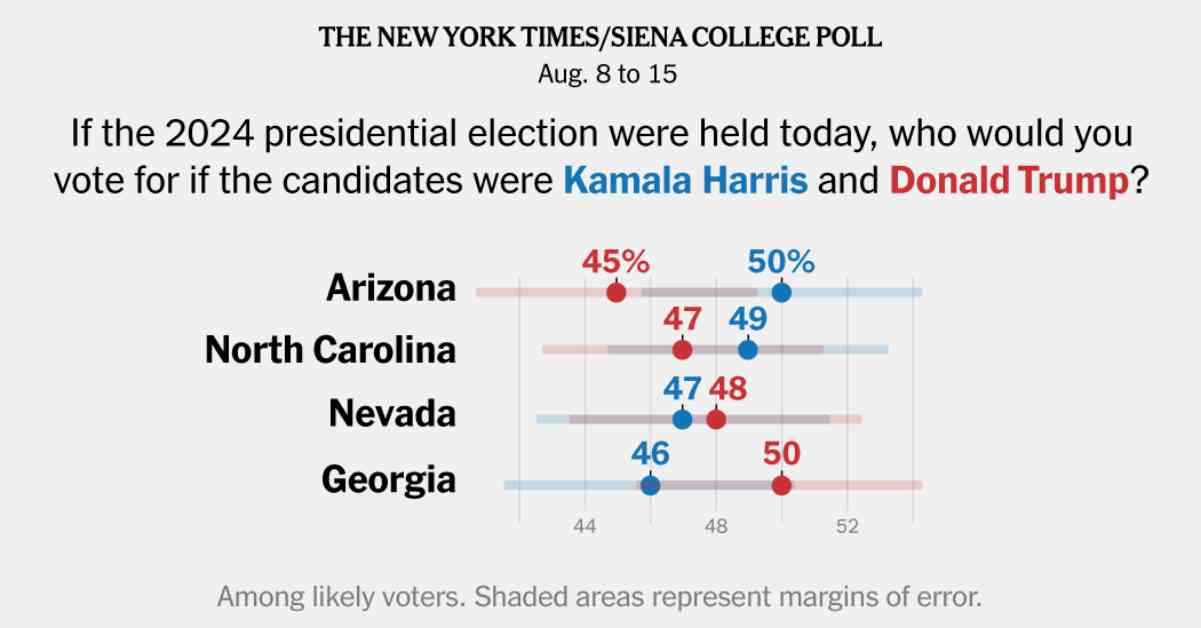Vice President Kamala Harris has made significant strides in reshaping the electoral map in key Sun Belt states, according to recent polls conducted by The New York Times and Siena College. The polls show that Harris is in a close race with former President Donald Trump in states such as Arizona, Georgia, Nevada, and North Carolina, which were previously considered strongholds for Trump.
Harris Gains Ground in Key Sun Belt States
The latest polls indicate that Harris has surged in popularity among likely voters in Arizona, leading Trump by a margin of 50 percent to 45 percent. Additionally, Harris has managed to edge ahead of Trump in North Carolina, a state that Trump won in the previous election. In Georgia and Nevada, Harris has significantly narrowed Trump’s lead, making the race too close to call.
This sudden shift in favor of Harris comes after Trump appeared to be on the path to securing these states when President Biden was still the Democratic nominee. The polls highlight Harris’s ability to connect with voters in diverse and rapidly growing states, positioning her as a formidable contender in the 2024 presidential election.
Impact on the Electoral Landscape
The resurgence of the Sun Belt states as battlegrounds in the upcoming election underscores the changing dynamics of American politics. Harris’s growing popularity in traditionally conservative states like Arizona and North Carolina signals a potential realignment in the electoral map, with Democrats gaining ground in regions that were previously considered safe for Republicans.
The close race between Harris and Trump in these states reflects the shifting priorities and concerns of voters, as well as the evolving demographics of the electorate. Harris’s appeal to a broad spectrum of voters, particularly in diverse communities, has played a significant role in her ability to reshape the electoral landscape in the Sun Belt states.
Analysis of Poll Data
The polls conducted by The New York Times and Siena College provide valuable insights into the preferences of voters in key states. The data shows that Harris and Trump are tied at 48 percent across an average of the four Sun Belt states surveyed, indicating a highly competitive race between the two candidates.
Compared to previous polls conducted in May, which showed Trump leading Biden by a significant margin, the latest results suggest a remarkable turnaround for Harris and the Democratic Party. The narrowing gap between Harris and Trump in states like Arizona, Georgia, Nevada, and North Carolina is a clear indication of the changing political landscape in the run-up to the 2024 election.
Public Perception of Candidates
The polls also shed light on how registered voters perceive Harris and Trump in terms of key attributes and qualities. According to the data, a significant percentage of voters believe that Harris cares about people like them and will bring about the right kind of change. On the other hand, Trump is seen as someone who flip-flops on issues that matter, which may have influenced voters’ preferences in the latest polls.
Overall, the public perception of the two candidates plays a crucial role in shaping voter attitudes and preferences, as reflected in the polling data. Harris’s ability to connect with voters on a personal level and inspire confidence in her ability to effect positive change has resonated with a wide range of voters, potentially tipping the scales in her favor in key battleground states.
In conclusion, the latest polls indicate a significant shift in the electoral map in favor of Vice President Kamala Harris, as she emerges as a strong contender in key Sun Belt states traditionally dominated by Republicans. The close race between Harris and former President Donald Trump underscores the changing dynamics of American politics and the evolving preferences of voters in diverse and rapidly growing regions. As the 2024 election approaches, the battle for these crucial states is likely to intensify, with Harris poised to make further gains in the race for the presidency.














